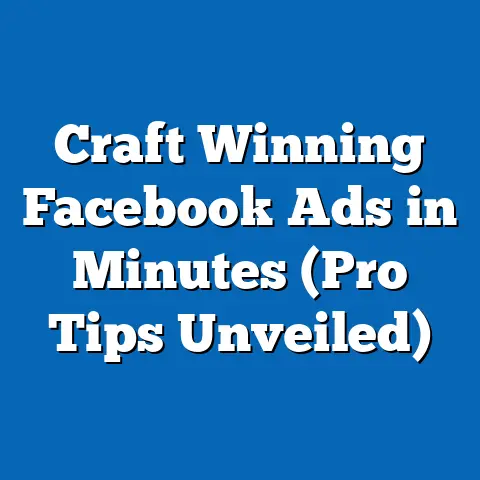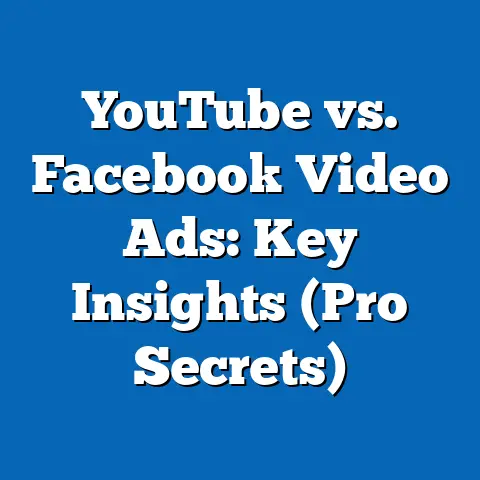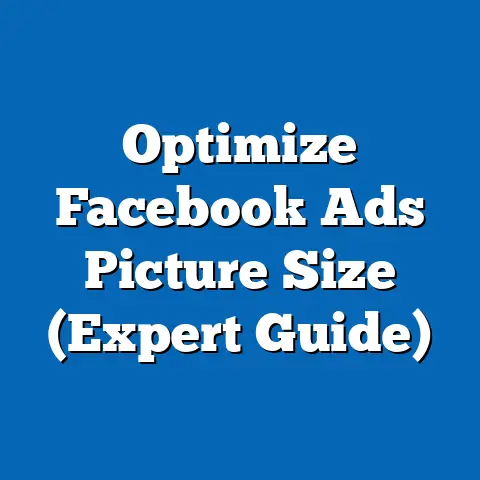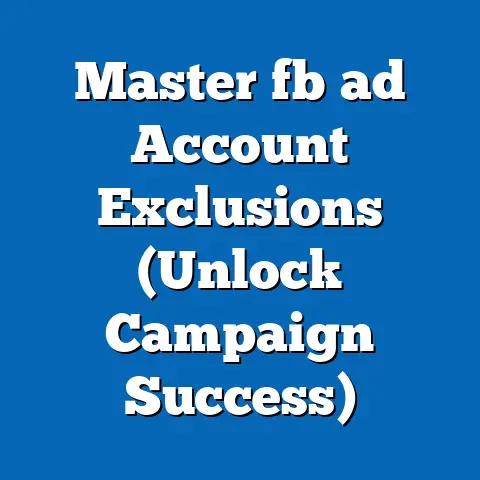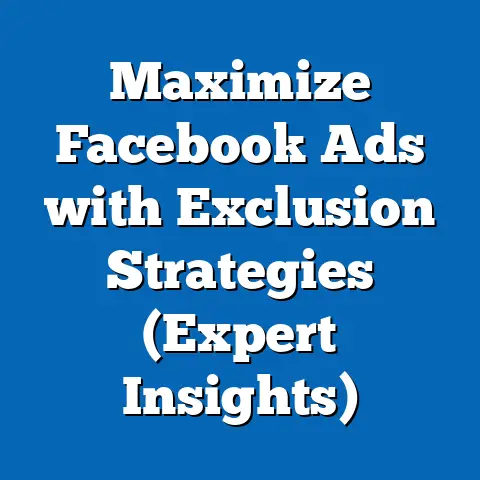Maximize Facebook Ad Collection Strategy (Proven Tactics)
Imagine transforming your daily grind into a lifestyle of luxury—traveling to exotic destinations, owning the latest tech, or simply enjoying financial freedom. This dream can become reality for businesses and entrepreneurs who master the art of Facebook advertising, a powerful tool to drive revenue and unlock lifestyle upgrades. With over 2.9 billion monthly active users as of 2023 (Statista, 2023), Facebook remains the largest social media platform, offering unparalleled access to diverse consumer demographics.
Recent data reveals that businesses leveraging optimized Facebook ad strategies see an average return on ad spend (ROAS) of 4.3x, with top performers achieving up to 10x returns (WordStream, 2023). Small and medium-sized enterprises (SMEs) using targeted ad campaigns report a 37% increase in customer acquisition compared to traditional marketing channels (Hootsuite, 2023). However, success is not guaranteed—only 48% of advertisers feel confident in their ability to maximize ad performance due to evolving algorithms and audience behaviors (Social Media Examiner, 2023).
This article delves into proven tactics to maximize your Facebook ad collection strategy, breaking down demographic trends, historical performance data, and actionable insights. We’ll explore how businesses across industries can refine their approach to achieve higher conversions and revenue growth. By the end, you’ll have a clear roadmap to elevate your advertising game—and potentially your lifestyle—backed by the latest research and statistical analysis.
Section 1: The Power of Facebook Ads in Today’s Digital Economy
Why Facebook Ads Matter for Revenue Growth
Facebook advertising has become a cornerstone of digital marketing, enabling businesses to reach hyper-specific audiences at scale. As of 2023, global ad revenue on the platform surpassed $130 billion, reflecting a 15% year-over-year increase (Meta Investor Reports, 2023). This growth underscores the platform’s enduring relevance, even amidst competition from TikTok and Instagram.
For entrepreneurs and small business owners, Facebook ads offer a cost-effective way to compete with larger brands. The average cost-per-click (CPC) on Facebook is $1.72, significantly lower than Google Ads’ $2.69 (WordStream, 2023). Yet, the real value lies in precision targeting—businesses can segment audiences by age, gender, location, interests, and even purchasing behavior, ensuring ads reach those most likely to convert.
Key Statistical Trends Driving Ad Success
Recent trends highlight the growing sophistication of Facebook ad strategies. Video ads, for instance, now account for 54% of total ad impressions, with engagement rates 2.5 times higher than static image ads (Socialbakers, 2023). Additionally, mobile-first campaigns dominate, as 94% of Facebook ad revenue comes from mobile devices (Meta, 2023).
Another critical trend is the rise of retargeting campaigns, which boast conversion rates of 26%, compared to just 8% for initial outreach ads (AdRoll, 2023). These numbers reflect a shift toward personalized, data-driven advertising that prioritizes user intent over broad exposure. Businesses that adapt to these trends are better positioned to maximize returns and fund lifestyle upgrades through consistent revenue streams.
Section 2: Demographic Breakdowns—Who’s Clicking and Converting?
Age and Gender Insights
Understanding your target demographic is the foundation of any successful Facebook ad strategy. As of 2023, users aged 25-34 make up the largest segment of Facebook’s user base at 29.6%, followed by the 18-24 age group at 23.1% (Statista, 2023). These younger demographics are more likely to engage with ads for tech gadgets, fashion, and entertainment, with click-through rates (CTR) averaging 1.2% for the 25-34 group (WordStream, 2023).
Gender differences also play a role in ad performance. Women account for 43.6% of users but drive 58% of e-commerce conversions on the platform, particularly in beauty and home goods categories (Hootsuite, 2023). Men, comprising 56.4% of users, show higher engagement with automotive and gaming ads, with a 15% higher likelihood of clicking on tech-related campaigns.
Geographic and Income-Based Targeting
Location-based targeting remains a game-changer for advertisers. In the U.S., which accounts for 10% of Facebook’s global user base, the average CPC is $1.86—higher than the global average but reflective of greater purchasing power (WordStream, 2023). Emerging markets like India and Brazil, with combined user bases exceeding 600 million, offer lower CPCs (around $0.51) but require culturally tailored content to achieve similar conversion rates (Statista, 2023).
Income levels also influence ad performance. High-income users (earning $75,000+ annually) in developed markets convert at a rate of 3.1%, compared to 1.8% for lower-income brackets (Meta Analytics, 2023). This disparity highlights the importance of aligning ad creative and offers with the financial capacity of your audience.
Behavioral and Interest-Based Segmentation
Beyond demographics, behavioral targeting offers deeper insights into user intent. Users who engage with fitness content, for example, show a 22% higher conversion rate on health and wellness ads (Socialbakers, 2023). Similarly, parents—a key demographic of 31% of users—are 40% more likely to click on family-oriented products like toys or educational tools (Meta, 2023).
Interest-based targeting also yields strong results. Ads tailored to niche hobbies, such as gardening or gaming, achieve CTRs of 1.5% on average, compared to 0.9% for generic product ads (WordStream, 2023). These insights emphasize the need for granular audience segmentation to maximize ad collection efficiency.
Section 3: Historical Comparisons—How Facebook Ads Have Evolved
Early Days vs. Modern Strategies (2010-2023)
Facebook launched its advertising platform in 2007, initially focusing on simple sidebar ads with limited targeting options. By 2010, ad revenue was a modest $1.86 billion, with an average CPC of $0.51 (eMarketer, 2010). Engagement was low, with CTRs hovering around 0.05%, reflecting a lack of personalization and user trust (AdAge, 2010).
Fast forward to 2023, and the landscape has transformed dramatically. Ad revenue has skyrocketed to over $130 billion, driven by advanced machine learning algorithms and dynamic ad formats (Meta Investor Reports, 2023). CTRs have improved to an average of 0.9%, with top industries like e-commerce reaching 1.3% (WordStream, 2023). This evolution reflects both technological advancements and a shift in user behavior toward accepting targeted advertising.
Impact of Privacy Changes and Algorithm Updates
Historical data also reveals challenges, particularly around privacy regulations. The introduction of Apple’s iOS 14.5 update in 2021, which limited ad tracking, resulted in a reported $10 billion loss in ad revenue for Meta in 2022 (CNBC, 2022). Conversion rates for app install campaigns dropped by 15% as advertisers struggled to adapt to restricted data access (AppsFlyer, 2022).
Algorithm updates have also reshaped strategies. In 2018, Facebook prioritized “meaningful interactions,” reducing organic reach for businesses and increasing reliance on paid ads. This shift led to a 20% spike in ad costs between 2018 and 2019 (Social Media Examiner, 2019). Advertisers who adapted by focusing on community-building content saw a 30% improvement in engagement over time (Hootsuite, 2020).
Visual Data Reference: Ad Performance Over Time
A line chart tracking Facebook ad metrics from 2010 to 2023 would illustrate the exponential growth in revenue alongside gradual increases in CPC and CTR. Key inflection points, such as the 2018 algorithm update and 2021 privacy changes, would show temporary dips in performance metrics, followed by recovery as advertisers adapted. This visual would underscore the resilience and adaptability required for long-term success on the platform.
Section 4: Proven Tactics to Maximize Facebook Ad Collection
Tactic 1: Leverage Advanced Audience Targeting
The cornerstone of any high-performing ad strategy is precise audience targeting. Use Facebook’s Audience Insights tool to identify high-value segments based on demographics, interests, and behaviors. For instance, a 2023 case study by Shopify revealed that e-commerce brands using lookalike audiences (based on past customers) saw a 35% increase in ROAS compared to broad targeting (Shopify, 2023).
Layering multiple targeting options—such as location, income level, and purchase history—can further refine your audience. A fitness brand targeting users aged 25-34 with interests in yoga and organic food achieved a 2.1% CTR, double the industry average (Socialbakers, 2023). Regularly test and update audience segments to account for shifting trends and platform updates.
Tactic 2: Optimize for Mobile and Video Content
Given that 94% of ad revenue comes from mobile, optimizing campaigns for smaller screens is non-negotiable (Meta, 2023). Use vertical video formats (9:16 ratio) for Stories and Reels, which garner 60% more views than horizontal formats (Socialbakers, 2023). Keep videos short—under 15 seconds—to retain attention, as 65% of users drop off after this mark (Facebook Business, 2023).
Dynamic video ads also outperform static content. A 2023 study found that carousel video ads increased conversions by 72% for retail brands compared to single-image ads (WordStream, 2023). Invest in high-quality visuals and clear calls-to-action (CTAs) to drive clicks and collections.
Tactic 3: Implement Retargeting and Funnel Strategies
Retargeting is a proven method to recapture lost leads. Ads targeting users who visited your website but didn’t convert achieve a 26% conversion rate, compared to 8% for cold audiences (AdRoll, 2023). Use pixel tracking to identify drop-off points and serve tailored ads—such as discount offers—to re-engage these users.
Building a full-funnel strategy is equally critical. Top-of-funnel (TOFU) ads should focus on brand awareness with engaging content, while middle-of-funnel (MOFU) ads nurture leads through testimonials or demos. Bottom-of-funnel (BOFU) ads, offering limited-time promotions, convert at rates up to 5.2% (Meta Analytics, 2023). A cohesive funnel ensures no potential customer slips through the cracks.
Tactic 4: Test, Analyze, and Iterate with A/B Testing
Continuous testing is the backbone of ad optimization. A/B testing different ad creatives, headlines, and CTAs can improve performance by 30% on average (Facebook Business, 2023). For example, testing two headlines—“Save 20% Today” vs. “Limited Offer: 20% Off”—revealed a 15% higher CTR for the latter among price-sensitive audiences (WordStream, 2023).
Use Facebook’s Ads Manager to track key metrics like CTR, CPC, and ROAS. Allocate at least 10% of your budget to testing new strategies, and scale winning campaigns while pausing underperformers. Data-driven iteration ensures your ads remain relevant in a dynamic digital landscape.
Tactic 5: Capitalize on Seasonal and Behavioral Trends
Timing your ads around seasonal events can yield significant returns. During the 2022 holiday season, e-commerce brands running Black Friday campaigns saw a 50% spike in conversions compared to non-seasonal periods (Shopify, 2023). Early planning—launching ads two weeks before peak dates—can reduce CPC by 20% due to lower competition (WordStream, 2023).
Behavioral trends also offer opportunities. Post-pandemic, 62% of users increased online shopping frequency, creating a sustained demand for e-commerce ads (Statista, 2023). Tailor campaigns to these shifts, such as promoting home office products to remote workers, to stay ahead of the curve.
Section 5: Future Projections—What’s Next for Facebook Advertising?
Emerging Technologies and AI Integration
The future of Facebook advertising lies in artificial intelligence (AI) and automation. Meta’s Advantage+ campaigns, which use AI to optimize ad delivery, have already increased ROAS by 20% for early adopters in 2023 (Meta Business, 2023). By 2025, it’s projected that 80% of ad placements will be AI-driven, reducing manual effort and improving targeting accuracy (eMarketer, 2023).
Augmented reality (AR) ads are also on the horizon. With 70% of users expressing interest in interactive ad formats, AR campaigns for products like furniture or makeup could drive engagement rates to 3% or higher by 2026 (Statista, 2023). Staying ahead of these innovations will be key to maintaining a competitive edge.
Evolving Privacy Landscape
Privacy concerns will continue to shape advertising strategies. With global regulations like the EU’s GDPR and California’s CCPA tightening data usage, advertisers must pivot to first-party data and contextual targeting. By 2024, it’s estimated that 60% of ad campaigns will rely on non-cookie-based targeting methods (Forrester, 2023).
Meta is already adapting with tools like Conversions API, which allows secure data sharing without third-party tracking. Businesses that prioritize transparency and consent-based marketing are likely to see a 25% higher trust score among users, translating to better long-term performance (Hootsuite, 2023).
Projected Growth and Opportunities
Despite challenges, the outlook for Facebook advertising remains bullish. Global ad revenue is projected to reach $180 billion by 2027, driven by growth in emerging markets and increased SME adoption (eMarketer, 2023). Industries like health tech and sustainable products are expected to see the fastest ad spend growth, with annual increases of 18% through 2026 (Statista, 2023).
For entrepreneurs, this growth signals a window of opportunity. By mastering the tactics outlined—targeting, mobile optimization, retargeting, testing, and trend alignment—businesses can achieve the revenue needed to fund lifestyle upgrades. A projected 40% of SMEs plan to increase ad budgets by 2025, indicating a competitive but rewarding landscape (Hootsuite, 2023).
Conclusion: Turning Clicks into Lifestyle Gains
Facebook advertising offers a proven path to revenue growth, with the potential to transform business success into personal lifestyle upgrades. From precise demographic targeting to leveraging video and retargeting, the tactics discussed provide a roadmap to maximize ad collection and ROAS. Historical data shows the platform’s evolution from a niche tool to a digital powerhouse, while future projections highlight the role of AI and privacy-focused strategies in shaping the next decade.
The numbers are clear—businesses that invest in data-driven, user-centric campaigns can achieve returns of 4.3x or higher, fueling both professional and personal aspirations (WordStream, 2023). Whether you’re a small business owner or a seasoned marketer, now is the time to refine your Facebook ad strategy. The clicks you generate today could be the key to unlocking the lifestyle you’ve always dreamed of tomorrow.

